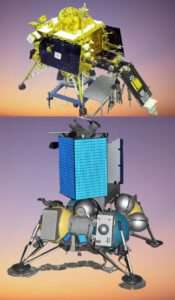As space agencies around the world continue to push the boundaries of exploration, two significant lunar missions—Russia’s Luna 25 and India’s Chandrayaan-3—stand out for their unique characteristics and ambitious goals. Notably, the manner in which these missions transport their spacecraft to the launch pad and the duration of their operational lifespans on the lunar surface are intriguing aspects that showcase the diversity of approaches in lunar exploration.

Russia and India are both planning to send missions to the moon in 2023. Russia’s Luna 25 is scheduled to launch in August(11th August), while India’s Chandrayaan-3 is already Launched in July 14. Both missions have similar goals: to land on the moon and study its surface. However, there are some key differences between the two missions.
Russia’s Luna 25: A Journey by Train & 1 Year Lunar Adventure
In a fascinating display of ingenuity and historical tradition, Russia’s Luna 25 rocket made its way to the launch pad via an unconventional mode of transportation—by train. This approach, while unusual by modern standards, has been a time-tested method employed by the Russian space agency, Roscosmos, for several decades. Transporting rockets by train allows for cost-effective and efficient movement of heavy space vehicles across vast distances to reach their designated launch sites.

India’s Chandrayaan-3: A 14-Day Lunar Adventure
The primary goal of Chandrayaan-3 is to successfully demonstrate precise lunar landings, a critical capability for future lunar missions. The lander will carry scientific instruments to analyze the moon’s surface and send back essential data to Earth. While the operational period may be relatively short, the mission is expected to provide valuable insights into lunar surface conditions and enhance India’s expertise in lunar exploration.

Diverse Mission Goals and Technical Considerations
The disparity in operational lifespans between Luna 25 and Chandrayaan-3 stems from their diverse mission goals and technical considerations. Russia’s Luna 25 mission seeks to conduct comprehensive and prolonged investigations on the lunar surface, necessitating an operational duration of approximately one year. In contrast, Chandrayaan-3 focuses on demonstrating critical landing capabilities and conducting specific experiments within its concise 14-day window.

A United Pursuit of Lunar Knowledge
Despite the differences in approach and mission durations, both Russia’s Luna 25 and India’s Chandrayaan-3 share a common objective: advancing our understanding of the moon and unlocking its mysteries. Lunar exploration is a global endeavor that unites nations in their pursuit of scientific knowledge and exploration beyond Earth’s boundaries.


Why the difference in lander lifespan:
There are a few reasons why Luna 25’s lander is designed to operate for a year, while Chandrayaan-3’s lander is designed to operate for just 14 days.
- Scientific instruments. Luna 25 is carrying a more sophisticated set of scientific instruments than Chandrayaan-3. These instruments require more power, which means that the lander needs to have a larger battery. A larger battery also means that the lander is heavier, which makes it more difficult to land.
- Landing site. Luna 25 and Chandrayaan-3 both are targeting the south pole of the moon, which is a more challenging landing site than the north pole. The south pole is covered in craters and mountains, which makes it more difficult for a lander to land safely. A longer lifespan gives Luna 25 more time to find a safe landing spot.
- Budget. The Chandrayaan-3 mission is a more affordable mission than the Luna 25 mission. This is because India is using a less sophisticated lander and a less powerful rocket. A shorter lifespan helps to keep costs down.

Which mission is more likely to succeed?

As these missions take flight and set foot on the lunar surface, they symbolize the unyielding human spirit of curiosity and the determination to explore the cosmos. As we look to the skies and beyond, the journeys of Luna 25 and Chandrayaan-3 inspire us to reach for the stars and unveil the secrets of the celestial bodies that beckon from afar.
